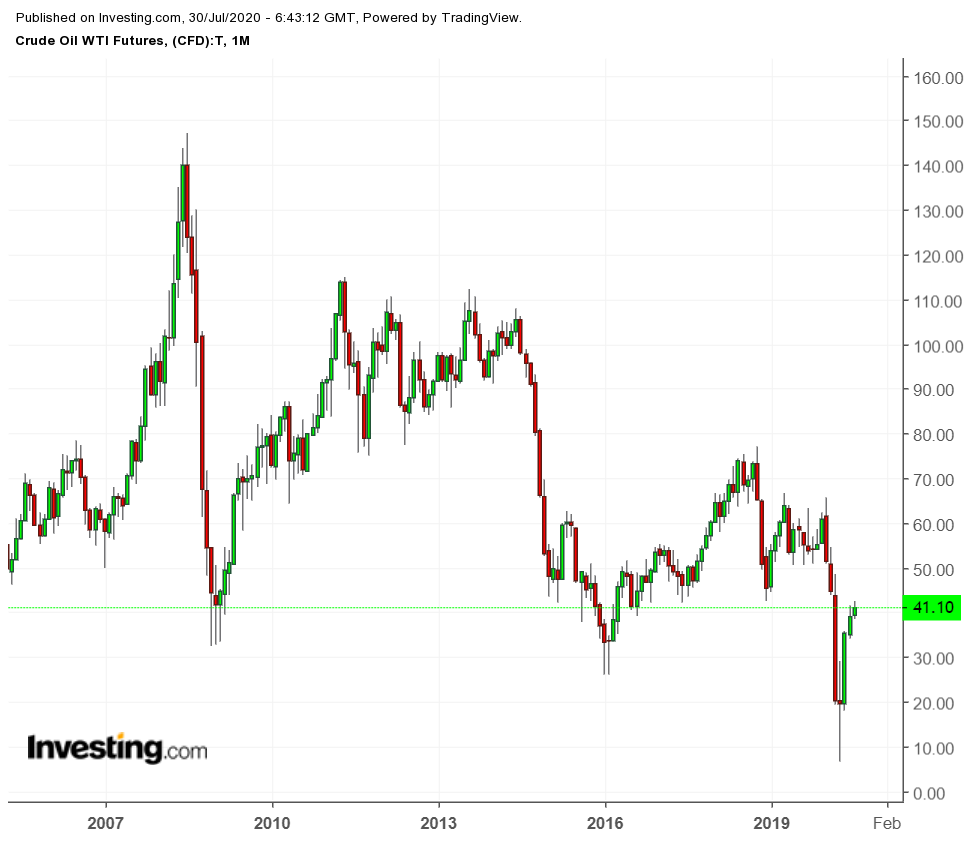July 30 marks six years since the US crude oil benchmark, WTI, was last above $100 per barrel. Six years prior, WTI reached its apex 12 years ago on July 3, 2008 when the spot price went over $145 per barrel.
Currently, the price of WTI is just barely above $40. What factors are keeping oil prices so depressed?

When oil prices are low, we often talk about a glut of the commodity, meaning more is being produced than consumed. In other words, supply outpaces demand, so prices drop. Oil goes into storage, and producers have to ask less in exchange for their product. But it’s not really that simple.
Some Consumers Are Also Storing
The supply and demand curve doesn’t directly correlate with oil prices, because sometimes the demand numbers are higher than the actual amount of oil being used. These numbers can be elevated because they include oil bought to be stored.
For example, China is the world’s most prolific importer of oil right now. While its economy does use a lot of oil, it also often stores large amounts of oil both through its communist government and via businesses—which ultimately must obey the government. Since a significant amount of the oil China might import in a given month is for inventory (storage), it will not agree to pay as much as if it absolutely needed that oil to survive. Similarly, if China can get a lower price, it will likely agree to buy more for inventory.
Peak Oil Vs Peak Demand
Part of the reason the price of oil climbed so high in 2008 was a theory of peak oil that became popular at the time. This theory, popularized by Matthew Simmons in his 2006 book Twilight in the Desert, said that there was much less oil available underground than previously thought. Particularly, Simmons argued that Saudi Arabia’s oil reserves were smaller than stated. When a vital commodity is scarce it becomes expensive, so the price of oil rose. It turned out that Simmons was incorrect.
Today, peak oil is not popular, but peak demand is. The most prevalent long-term forecast for the oil market says there will be much lower demand for oil in the coming decades, based on predictions about future developments in the industry.
Some believe electric vehicles will be the predominant form of automobiles and trucks by 2040 or 2050, renewable energies and nuclear plants will make oil and gas power generation outdated and plastics and fertilizer will be made with less oil due to recycling and new innovations. While we don't know if these theories will come to fruition, they do drag down oil prices.
Recession Fears Weigh On Prices
In the early summer of 2008, when WTI was at its peak, a recession was just around the corner, but few guessed that.
The price of oil was high in large part because of the promise of the future. Only two months later, the global economy started to collapse. But on July 3, when crude was at its highest, no one knew what was coming. The oil industry, big oil consumers (like refineries) and traders were completely blind-sided.
In 2018 and 2019, economic forecasting was rife with predictions that a recession was coming, and these warnings were usually based on fear of a global trade war or inverted yield curves. In fact, it was a global pandemic and the reaction to the health crisis that ultimately caused an economic downturn precisely when no one predicted it.
OPEC Not The Market Stabilizer It Once Was
In July of 2014, the price of WTI was still over $100, because no one really believed that there would be an excess of oil produced. Even though Saudi Arabia’s then-oil minister Ali al-Naimi indicated just a few weeks earlier that he was willing to see OPEC overproduce oil, there was still a belief that a price collapse couldn’t happen.
Less than six months later, WTI had lost more than half of its value. Since 2016, OPEC and its auxiliary group, OPEC+, have attempted to raise oil prices multiple times, but their efforts have proven to be no more than minimally effectual. Even before the coronavirus outbreak, triple-digit oil prices seemed like an eternity away despite the efforts of OPEC+.
Actual Production Numbers Are Complicated
The biggest change in oil production in recent years has been the boom in US shale output. Right now, the US is producing about 11 million bpd, that figure stood at 13.1 million bpd before the coronavirus outbreak hit the economy. Compare that to the 8.7 million bpd the US produced (on average) in 2014 or the 5 million bpd (on average) in 2008.
At the same time, Venezuela’s output has drastically decreased, in large part because it cannot afford to produce its own oil. Output there is down to 280,000 bpd from an average of 2.3 million bpd in 2014 and 2.34 million bpd in 2008.
Iran is not producing much, because it is hampered with sanctions. Its numbers today are 2 million bpd compared to 2.76 million bpd in 2014 and 3.88 million bpd in 2008.
Overall, the world produces more oil today because of new wells that have come online along with new technologies and efficiencies. One fear that does not exist at the moment is a shortage of oil. Rather, those who buy and sell oil worry about a lack of demand, and it has been that way since the second half of 2014. That is why the prices have not returned to triple digits in six years.
But the best lesson from the last twelve years is this: we can’t predict the future.
